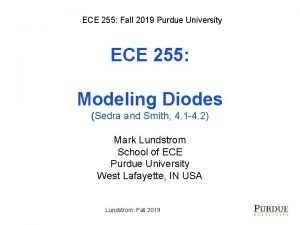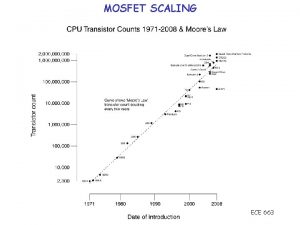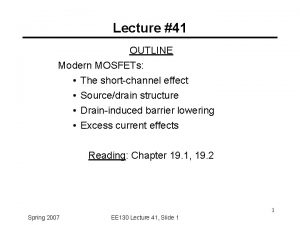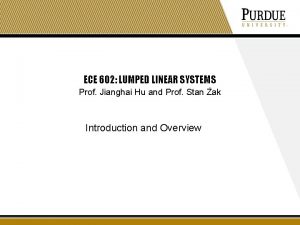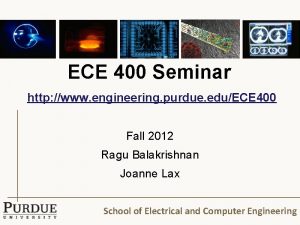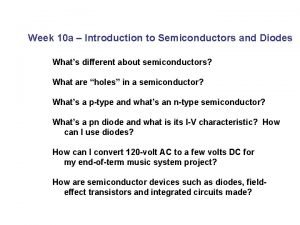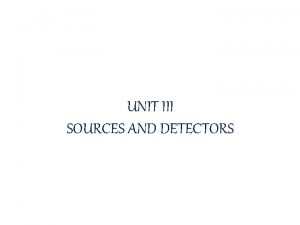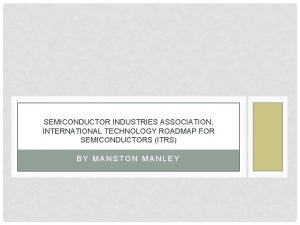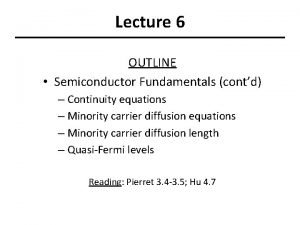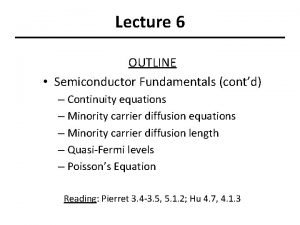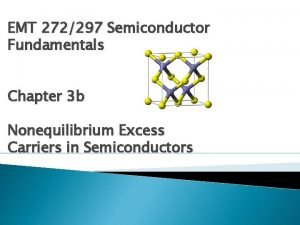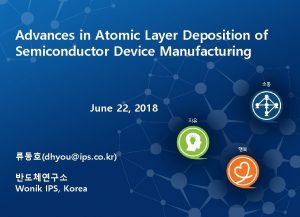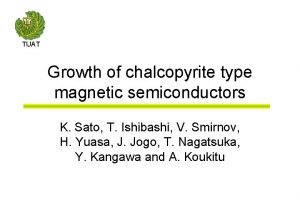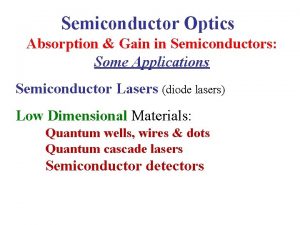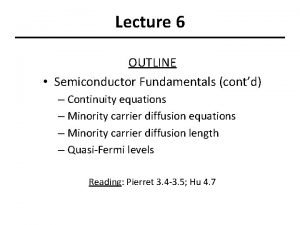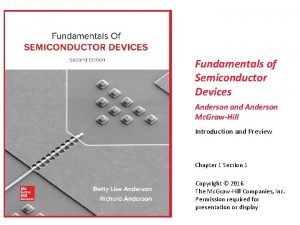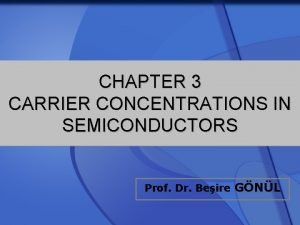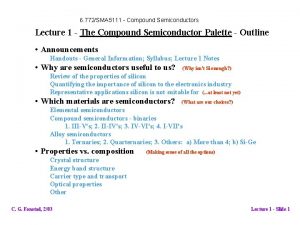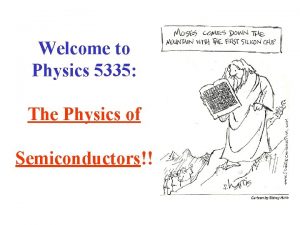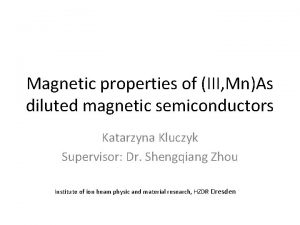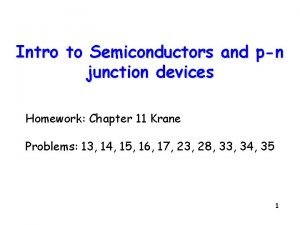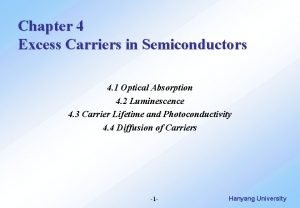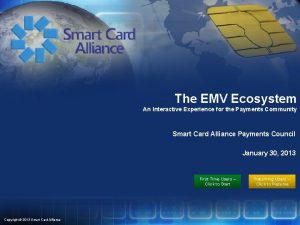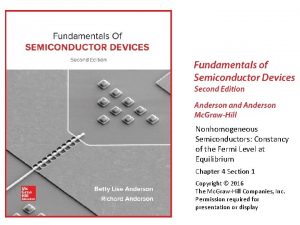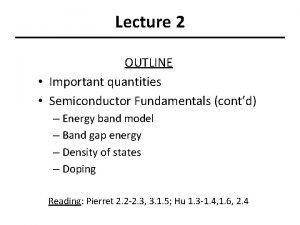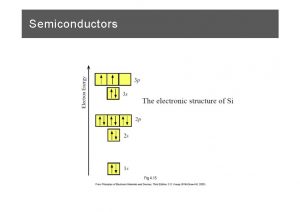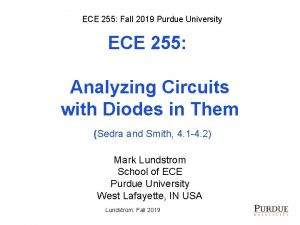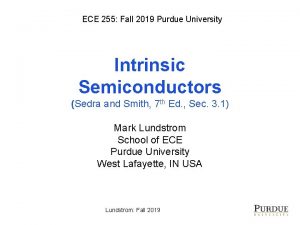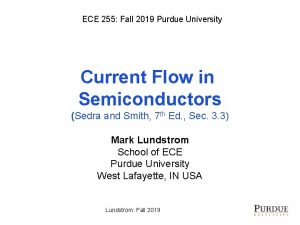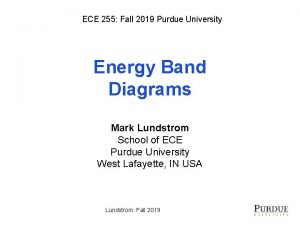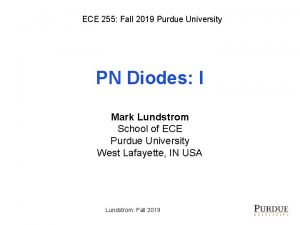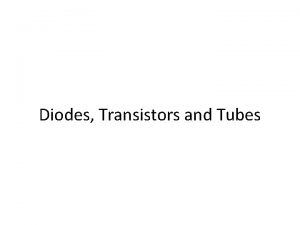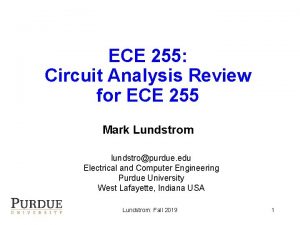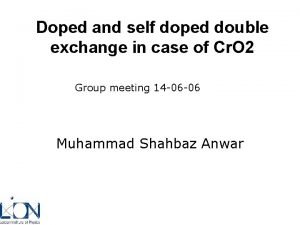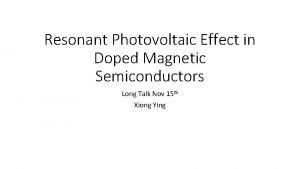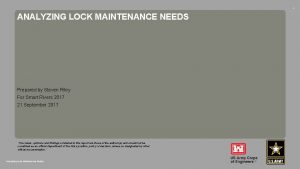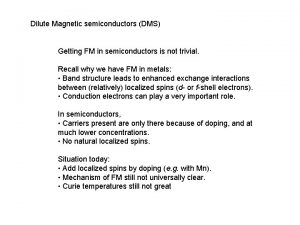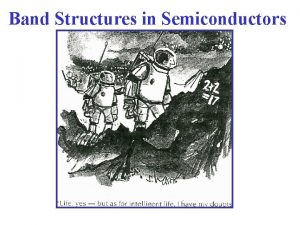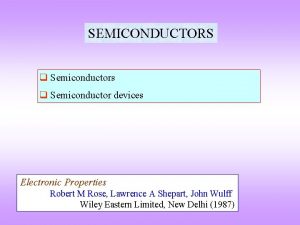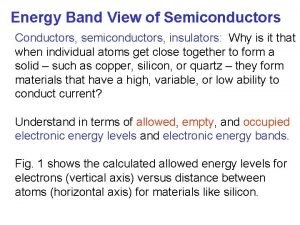ECE 255 Fall 2019 Purdue University Doped Semiconductors































- Slides: 31

ECE 255: Fall 2019 Purdue University Doped Semiconductors (Sedra and Smith, 7 th Ed. , Sec. 3. 2) Mark Lundstrom School of ECE Purdue University West Lafayette, IN USA Lundstrom: Fall 2019 1

Doping makes semiconductors useful metal semiconductor insulator “doping” gold (Au) silicon (Si) Lundstrom: Fall 2019 glass (Si. O 2) 2

Doped semiconductors 1) 2) 3) 4) The n 0 p 0 product Doping Carrier concentration vs. doping density Carrier concentration vs. temperature Lundstrom: Fall 2019 3

Quick re-cap Si atom (At. no. 14) energy 4 s 0 3 p 6 Intrinsic Si crystal conduction band • • • 3 s 2 2 p 6 2 s 2 1 s 2 • • • valence band position 4

The equilibrium n 0 p 0 product For intrinsic semiconductors: Silicon T = 300 K ni is typically small at room temperature, but can become large at high temperatures. Lundstrom: Fall 2019 5

Generation and Recombination requires energy to break covalent bonds releases energy In equilibrium: G = R and n 0 = p 0 = ni Lundstrom: Fall 2019 6

Doping a semiconductor Gallium or boron Phosphorus or Arsenic “P-type doping” “N-type” doping Lundstrom: Fall 2019 7

Dopants in Si column IV P-type dopants come from column III N-type dopants come from column V Lundstrom: Fall 2019 8

Donors: N-type doping Weakly bound Easily broken at room temperature Phosphorus or Arsenic Produces an electron in the conduction band. Lundstrom: Fall 2019 9

Ionized donor Concentration of dopants: Concentration of ionized donors: + Concentration of electrons in the conduction band: Ionized donor Lundstrom: Fall 2019 10

Calibration (moderate doping density) This looks like a big number, and it is, but also it’s really quite small. Lundstrom: Fall 2019 11

Carrier concentrations Phosphorous or arsenic doped Si at 300 K Example: extrinsic N-type semiconductor Lundstrom: Fall 2019 12

Carrier concentrations Note that the N-type doping increased n 0, but it decreased p 0. Lundstrom: Fall 2019 13

Be careful about units! We will be working in SI (MKS) units. The carrier concentration should be given per cubic meter, but semiconductor people like to mix their units. It is safest to do the calculations in SI units, and then convert to cubic cm. Lundstrom: Fall 2019 14

Acceptors: P-type doping Missing bond Boron or gallium Lundstrom: Fall 2019 15

Ionized acceptor Concentration of dopants: Concentration of ionized acceptors: _ Ionized acceptor Concentration of “holes” in the valence band: Lundstrom: Fall 2019 16

Carrier concentrations Example: extrinsic P-type semiconductor Lundstrom: Fall 2019 17

Doped semiconductors ✓ 1) ✓ 2) 3) 4) The n 0 p 0 product Doping Carrier concentration vs. doping density Carrier concentration vs. temperature Lundstrom: Fall 2019 18

Space charge density The net charge in this region: bulk, uniform semiconductor Lundstrom: Fall 2019 19

Space charge neutrality “Nature abhors a vacuum. ” Nature also abhors a charge. Mobile charges (electrons and holes) will be attracted to the immobile ionized dopants), so that the net charge is zero. Almost uniform semiconductors will be nearly neutral, but with strong non-uniformities (e. g. PN junctions), there will be a space charge. Lundstrom: Fall 2019 20

Space charge neutrality + np product Always true in equilibrium –even for doped semiconductors. These are two equations in two unknowns –p 0 and n 0. Lundstrom: Fall 2019 21

Solving for the carrier density 1) charge neutrality: 2) eq. np product: 3) result: Lundstrom: Fall 2019 22

N-type extrinsic semiconductors at moderate temps Extrinsic semiconductors: Lundstrom: Fall 2019 23

P-type extrinsic semiconductors at moderate temps Lundstrom: Fall 2019 24

Example 1 Consider Si doped with phosphorus at ND = 2. 00 x 1015 cm-3 The temperature is 300 K. What are n 0 and p 0? Recall that at 300 K in Si, ni = 1. 00 x 1010 cm-3 Assume that the donors are fully ionized. 25

Example 2 Consider Si doped with phosphorus at ND = 2. 00 x 1015 cm-3 and Boron at NA = 1. 00 x 1015 cm-15. The temperature is 300 K. What are n and p? Lundstrom: Fall 2019 26

Summary (room temperature) Fully ionized: Extrinsic: Intrinsic: In between: Lundstrom: Fall 2019 27

Carrier concentration vs. temperature High temperatures: Moderate temperatures: Low temperatures: 28

Carrier concentration vs. temperature freeze out extrinsic intrinsic 1. 0 0 K 300 K Lundstrom: Fall 2019 600 K 29

Summary To dope a semiconductor, we replace a few atoms with atoms from a different column of the periodic table. Ionized dopants produce electrons in the conduction band or holes in the valence band. The carrier concentration vs. temperature characteristic has freeze out, extrinsic, and intrinsic regions. A low temperatures, semiconductors become insulators. A high temperatures, doped semiconductors become intrinsic. Lundstrom: Fall 2019 30

Doped semiconductors 1) 2) 3) 4) The np product Doping Carrier concentration vs. doping density Carrier concentration vs. temperature Lundstrom: Fall 2019 31
 0 255
0 255 Ece 255
Ece 255 Retrograde well
Retrograde well Lightly doped drain
Lightly doped drain Ece 602 purdue
Ece 602 purdue Purdue medical physics
Purdue medical physics Cs 514 purdue
Cs 514 purdue Ee 170 purdue
Ee 170 purdue Introduction to semiconductors
Introduction to semiconductors Direct and indirect band gap semiconductors
Direct and indirect band gap semiconductors Semiconductor industry association
Semiconductor industry association International roadmap for semiconductors
International roadmap for semiconductors Derive equation of continuity
Derive equation of continuity Equation of continuity in semiconductors
Equation of continuity in semiconductors Equation of continuity in semiconductors
Equation of continuity in semiconductors Semiconductor
Semiconductor Konduktor isolator dan semikonduktor
Konduktor isolator dan semikonduktor Equipement used for making semiconductors
Equipement used for making semiconductors Optical loss and gain in semiconductors
Optical loss and gain in semiconductors Derivation of continuity equation in semiconductor
Derivation of continuity equation in semiconductor Fundamentals of semiconductor devices
Fundamentals of semiconductor devices Acceptor concentration formula
Acceptor concentration formula Elemental and compound semiconductors
Elemental and compound semiconductors The physics of semiconductors
The physics of semiconductors σsk
σsk Intro to semiconductors
Intro to semiconductors Excess carriers in semiconductors
Excess carriers in semiconductors International technology roadmap
International technology roadmap Bank of america semiconductors
Bank of america semiconductors Semiconductor and its types
Semiconductor and its types Whats semiconductor
Whats semiconductor Semiconductors band gap
Semiconductors band gap

